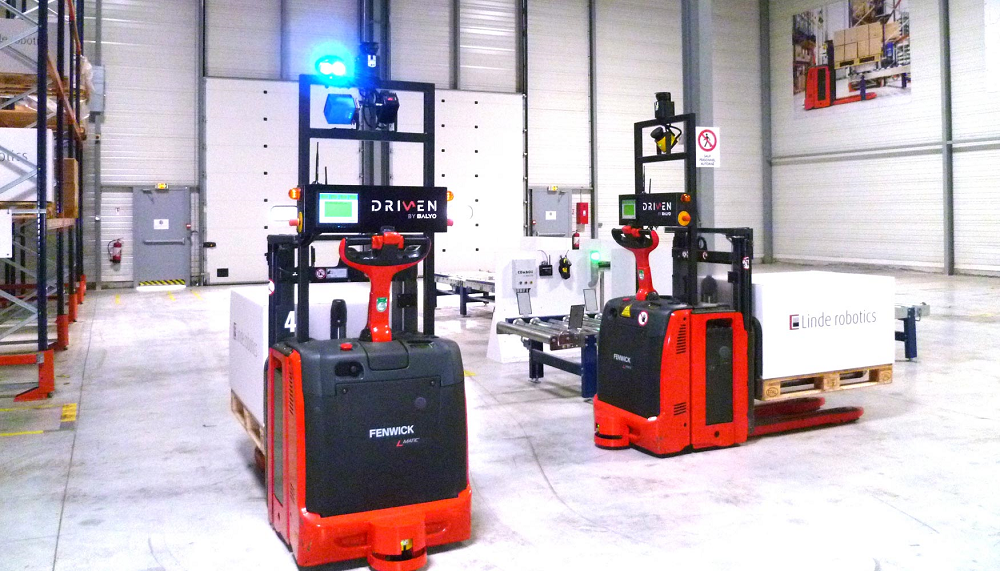Autonomous models for the warehouse
26th February 2016

Linde Material Handling will be launching two new models from its innovative Linde-MATIC robotic truck series in time for the LogiMAT trade fair. The Linde T-MATIC pallet truck and the Linde L-MATIC AC counterbalance pallet stacker will complement the current range on offer. Lindes goal for the medium term is to offer one robotic version for each of its major product series, in cooperation with French robotic specialist Balyo. Further models are to be presented as early as next May at the manufacturers World of Material Handling (WoMH) customer event which lasts for two and a half weeks.
Tomorrows intralogistics will be digitally networked and increasingly automated. With the MATIC series, one year ago Linde introduced its first warehouse trucks that are able to navigate autonomously in the warehouse without additional infrastructure. The trucks can react to obstacles in real time, are scalable and flexibly adjustable to new warehouse layouts. Routes and driveways in the mapped area can be learnt quickly and easily. The trucks perform their tasks independently of working hours and provide maximum traffic safety. In combination with wireless LAN modules (so-called COMBOXes), the vehicles supervision software ensures the connection with roller shutters, belt conveyors and pallet stretch wrapping machines, receives orders from corporate ERP or Warehouse Management Systems (WMS) and translates them into transport orders.
Lindes robotic trucks offer logistics managers the possibility to network their internal material flow gradually, step by step: Where operating conditions are simple, the trucks can work on a stand-alone basis, without connection. In this case, transport orders are triggered directly via the trucks touch screen or are programmed in the trucks computer. In a next stage, the robotic vehicles communicate via the Supervisor software and interfaces with individual machines and installations, for example a bar code scanner or a presence sensor at the end of a roller conveyor. The robotic pallet stacker will then drive there, pick up the pallet and transport it to the requested destination, for example, the material buffer of a production plant. In stage three, the supervision software of the Linde-MATIC trucks can exchange data with the corporate WMS or the ERP system. The computing unit manages incoming orders, assigns route-optimised transport jobs, receives feedback from the trucks and manages the traffic, thus adding swarm intelligence to the fleet.
New trucks extend range of Linde Robotics
In spring 2015, Linde presented its first robotic trucks: the Linde L-MATIC pallet stacker and the Linde P-MATIC tractor. The pallet truck Linde T-MATIC following now features long forks for transporting two pallets at a time. To this end, the robotic truck has a lifting capacity of three tonnes. By comparison, the Linde L-MATIC AC counterbalance pallet stacker facilitates the transport of closed load carriers and is predestined for picking up loads at P&D stations that are not accessible from underneath by the load arms (e.g. roller channels). It can accommodate loads of up to 1.2 tonnes. The four currently available robotic models, which are all based on the respective Linde standard trucks, can cover a wide range of tasks in the warehouse.
Users in a wide range of industries
To date, the robotic trucks are mainly used in the transport of pallets and trailers. The distances covered can extend to up to several hundred meters. Usually the goods are moved between warehouse and the manufacturing area in order to ensure production supply and removal. The vehicles are also used to bring goods to an intermediate or bulk storage section after unloading from the lorry, or to consolidate different products prior to loading the lorry. Initial customers for Linde robotics trucks come from the automobile industry and automotive suppliers, chemical and pharmaceutical industries, mechanical engineering, food sectors as well as some of top 3PL (third-party logistics).The number of industrial trucks in a plant or warehouse ranges from just a few to fleets of 20 to 30 vehicles. Automated Robotic trucks are usually in use together with manually-operated industrial trucks, forming mixed fleets, and they interact with each other, for example, in the hand-over of load carriers.

